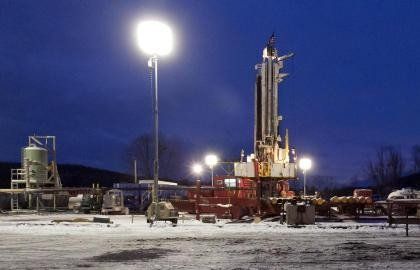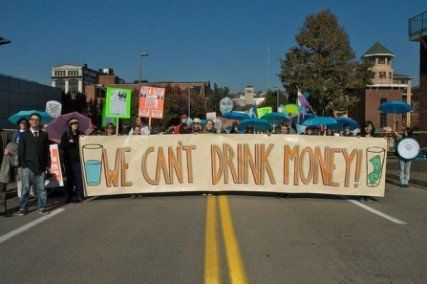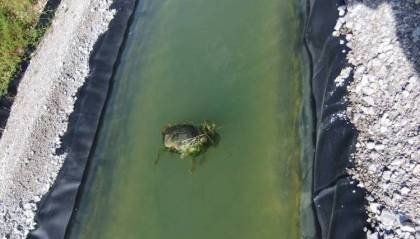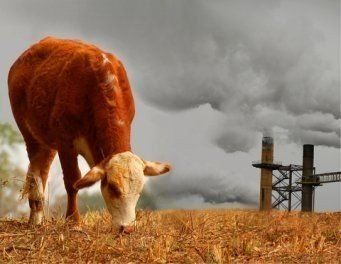Impact on the Environment
Fracking causes increased air, noise and light pollution, and each well produces millions of gallons of toxic waste water, which is very difficult to dispose of safely. In countries where fracking has taken place there have been significant impacts on the natural environment, including water contamination, methane leaks, spills of fracking chemicals, earthquakes and loss of wildlife. Many countries, such as Scotland, Ireland and France, have already banned fracking due to serious health and environmental concerns.

If you want a good place to start, please read this summary of the impacts of fracking by the Concerned Health Professionals of New York from March 2018, which accompanied the publication of the fourth edition of their Compendium of the Scientific Risks of Fracking, which you can read here.
We challenge anyone to read this extraordinarily thorough and well-researched document, which draws from over 900 peer-reviewed studies on the impacts of fracking, and still say that fracking does not cause harm to the environment and human health.
And regulations won’t save us either ,whatever the government claims. As the summary of the 2nd edition
of this Compendium states: "Growing evidence shows that regulations are simply not capable of preventing harm. That is both because the number of wells and their attendant infrastructure keeps increasing and, more importantly, because some of fracking’s many component parts, which include the subterranean geological landscape itself, are simply not controllable.”
FRACKING’S IMPACT ON DRINKING WATER
“Cases of drinking water sources contaminated by drilling activities, as well as waste disposal, are now proven.” Physicians for Social Responsibility, Oct 2015.
One major area of concern is the impact that fracking can have on drinking water. Contamination of underground drinking water sources (aquifers) and surface water courses (rivers, lakes and streams) can occur for various reasons, such as loss of well integrity, spills and leaks of chemicals or waste water at the well-site and migration of waste water through underground faults.

This has been a contentious issue in the USA, where the fracking industry has fought hard to prevent the scope of water contamination from becoming public knowledge. One reason why it’s hard to get all the facts about the true extent of water pollution is that farmers and landowners who have their private boreholes contaminated are often forced to accept a free weekly supply of water trucked in by the gas companies, on the condition that they sign non-disclosure agreements (effectively gagging orders to prevent them from speaking out).
Despite this, there are numerous incidences of water contamination due to fracking or fracking-related activity in the US, many of which are making their way through the courts. Many others have been settled out of court with the addition of a gagging order of the plaintiff. Here are just a few of the cases that have seen the light of day – and where better to start than Dimock, Ohio, famous for the ‘burning tap water’ images from the film Gasland?

DIMOCK, OHIO In 2009, heavy concentrations of methane contaminated the drinking water of several dozen families In Dimock, Ohio. This notorious case – which resulted in people being able to set fire to their tap water
– has become the ‘ground zero’ for water contamination lawsuits in the US, which is well documented in this State Impact article. You can hear Dimock resident Norma Fiorentino’s story of how her drinking water well blew up in her own words here,
and read an in-depth report on this case in the Scientific American.
The US Environmental Protection Agency (EPA) also stated after an long-running investigation that drilling for fracked gas caused ‘significant damage’ to aquifers in the area, as reported in ohio.com.
BRADFORD COUNTY, PENNSYLVANIA In 2012 Chesapeake Energy paid $1.6 million in damages to three families from Wyalusing, Bradford County for contamination of their water supply, as described in this State Impact article. This was one of the first cases that didn’t come with a gagging order, as the plaintiffs refused to sign a confidentiality agreement. “They wanted the public to know what the settlement was about,” said the lawyer for two of the families, Todd O’Malley.
Research published
in 2015 the Proceedings of the National Academy of Sciences also showed evidence of a connection between gas drilling and water contamination that occurred in Bradford County in 2010.
POTTER COUNTY, PENNSYLVANIA In September 2015, Two public drinking water systems were impacted and at least five private water supplies contaminated due to ongoing pollution being caused by a natural gas fracking operation of JKLM Energy in Potter County, Pennsylvania. Read more on the Public Herald website.
COOKING THE BOOKS A 30-month investigation by the investigative news website Public Herald
in Pennsylvania showed that the Department of Environmental Protection in Pennsylvania ‘cooked the books’ by wrongly assigning or shredding complaints about fracking and water contamination in the state. This case involved over 2,000 complaints. You can read more about this here.
Further detailed investigations into the impact of fracking on the water supplies in Pennsylvania can be found on the Public Herald
and State Impact websites.
ALBERTA, CANADA
Meanwhile, in Canada, landowner and oil industry consultant Jessica Ernst sued oil and gas company EnCana and the state regulators for contamination of the water supply on her farm. You can read about her story here, or watch a recent talk she gave while visiting the UK here.

THE EPA REPORT The U.S. Environmental Protection Agency released the final version
of a six-year, $29 million study in December 2016, highlighting the conclusion that hydraulic fracturing has caused contamination to drinking water resources across the country.
Tom Burke, EPA Deputy Administrator, said the study produced significant findings. Key among them was that fracking has caused contamination to drinking water resources. “We found scientific evidence of impacts to drinking water resources at each stage of the hydraulic fracturing water cycle," he said.
The reported identified a number of reasons for this contamination, such as injection of fracking fluids directly into groundwater resources, spills and leaks, discharging waste water to surface water and spills of chemicals and fracking fluids.
The EPA report has had something of a chequered history, as you can read in this press report or on the desmog blog.
You can also read the executive summary
of the report, or the full report.
PLAUSIBLE DENIABILITY? Given the clear evidence that fracking has impacted people’s water supplies – a fact even admitted by the US Environmental Protection Agency – how come supporters of shale gas can keep claiming that there have been no incidents of fracking contaminating water supplies? This defence often relies on a very narrow definition of fracking to mean the actual fracturing of the shale rock deep underground, rather than referring to the complete unconventional gas production process. So, by this logic, the industry can then claim that any contamination due to well integrity failure, leaks, surface spills, underground migration, etc, is not caused by what they define as ‘fracking’. However, if you have lost your water supply and have to rely on the gas company providing you with tankers of water for the rest of your days (and were asked to sign a gagging order preventing you from talking to the media about what had happened), it probably doesn’t matter much which part of the gas extraction process caused it – you would still feel well and truly fracked.
AIR QUALITY
Research conducted by scientists from Oregon State University and the University of Cincinnati in the USA has concluded that people living or working near active natural gas wells may be exposed to certain pollutants at higher levels than the Environmental Protection Agency considers safe for lifetime exposure, according to Daily. The researchers found that fracking emits pollutants known as PAHs (polycyclic aromatic hydrocarbons), including some that are linked with increased risk of cancer and respiratory ailments.

Traffic related to fracking is also a key problem relating to air quality. A study
by researchers from ReFine, a group of researchers at Newcastle University investigating the impacts of fracking, points to a likely rise in dangerous pollutants such as NO2 caused by the number of HGV journeys to and from well-sites. “The traffic impact of a single well pad can create substantial increases in local air quality pollutants during key activity periods,” the study said.
IMPACT ON WILDLIFE
There are disturbing reports of long-term impacts of fracking on local wildlife populations. Here are some of the damaging consequences of fracking in the USA, as described by the Center for Biological Diversity.
Fish kills in Pennsylvania have been associated with the contamination of streams, creeks and wetlands by fracking fluid.

Farmers, pet owners and veterinarians in five states — Colorado, Louisiana, Ohio, Pennsylvania, and Texas — have reported deaths, serious illnesses and reproductive problems among wildlife, as well as horses, cattle, cats and dogs exposed to fracking infrastructure or wastewater.
Withdrawing water from streams and rivers for fracking can threaten fisheries.
Birds and other wildlife have been poisoned by chemical-laced water in wastewater ponds and tanks used to dispose of fracking fluids.
Equipment used to withdraw water for fracking activity has been implicated in the introduction of invasive species into creeks and rivers, causing fish kills.
Sensitive bird species and other wildlife can be affected by drilling noise, truck trips and other effects from gas drilling pads. One study found that a single drilling station can affect 30 acres of forest. Effects on wildlife include degradation of habitat and interference with migration and reproduction.
The diversity of species in streams close to fracking activity in Pennsylvania was found to be reduced, even though drilling was done in accordance with all current state rules.
Wastewater ponds resulting from gas extraction provide breeding grounds for mosquitoes that can transmit diseases such as the deadly West Nile Virus to wild birds. In California, oil and gas companies are fracking in several counties with West Nile virus activity, including Kern County, which has had a human case.
This is a particular concern in the UK, where almost two thirds of potential fracking sites are considered to be rich in important wildlife, according to research cited in The Guardian. For another summary of the impact fracking could have on animals and wildlife, please see this Ecowatch
article.
Finally, for a review of current peer-reviewed research, please see PSE Healthy Energy, a multi-disciplinary scientific research institute that supports the adoption of evidence-based energy policies. Their 2016 review
of relevant scientific literature from 2009-15 focused on human health, water quality and air pollution. This review states that at least 685 papers have been published in peer-reviewed scientific journals during that time frame which are relevant to assessing the impacts of fracking. Of these, 69% of water quality studies contain findings that indicate potential, positive association, or actual incidence of water contamination and 87% of air quality studies contain findings that indicate elevated air pollutant emissions and/or atmospheric concentrations. You can also read a summary of this this report here.
Copyright © All Rights Reserved.
